Underwater predators. Submarine type "Sh" ("Pike")
Boats took an active part in the hostilities during the Great Patriotic War. During the war years, these submarines sank 45 and damaged 8 of enemy warships and commercial ships - more than a third of the total number of ships sunk by all Soviet submarines. At the same time, an 44 submarine died from 31 submarines that fought. For military merits 6 submarines of type "Sh" became Guards, another 11 submarines were awarded the Order of the Red Banner.
The design of the first submarines of the III series of the Pike type was carried out in parallel with the design of the submarines of the I Dekabrist series. "Pike" was a polutorakorpuznuyu submarine, its robust hull was divided into 6 compartments. The project was developed in the design office, which was headed by B. M. Malinin. Initially, the boats were designed as small ones; they were intended for operations in the Baltic areas that were constrained by navigation. They were planned to be used in the water area of the Gulf of Finland with its small depths, skerries and narrow places. In the future, according to the pre-war classification adopted in the USSR, the boats were classified as average.
The first series of U-type submarines, the Series III, was created by Soviet engineers in an incredible rush. The outline sketch of the boat was completed at the end of 1929 of the year. Without waiting for approval, the Baltiysky plant began to create working drawings. At the same time, at the design stage, numerous changes were made to their design. For example, the military demanded to place spare torpedoes on board the boat. Placing on board four more torpedoes demanded manifestations of ingenuity from the Pike designers.
It is interesting that the U-boat design was influenced by the raising and inspection of the British submarine L-55, which since October 1929 has been undergoing refurbishment in Kronstadt. From this boat, the Pike got contours with linear transformation and a common architectural type: one and a half hull, with Boolean tanks of the main ballast. The English boat L-55 sank in the southern part of the Gulf of Finland on June 4, 1919 during an attempt to attack the destroyers Azard and Gabriel. As a result of the demolition of the boat by an unaccounted current, it was blown up on an English mine barrier. In the summer of 1928 the boat was successfully raised to the surface, and then restored and incorporated into the Soviet fleet. When raising and examining the boat, the remains of 38 English submariners were discovered, which were transferred to the British side for burial at home.
Tactical and technical characteristics of submarines of the type "Sh" changed from series to series slightly. A total of 86 boats were built in six different series. Mainly, there was a change in the characteristics of the boats in the direction of the power of the installed diesel engines, increasing the speed of surface and underwater travel, a certain decrease in cruising range. The armament of the boats (four bow and two stern torpedo tubes and two 45-mm artillery guns) remained unchanged (except for four series III boats armed with one gun). Submarines of the Pike type had 6 compartments in a solid hull: the first and sixth compartments were torpedoes; the second one is residential (in it, under the collapsible flooring of wooden shields, there were batteries, and under them fuel tanks); the third compartment is the central post of the boat; the fourth is the diesel compartment; in the fifth compartment there were two main electric motors and separately - two electric motors of the economic course.
Since from the very beginning of work on the project, new submarines were considered as massive, the main requirement for them was the maximum simplicity of the design. Such a requirement was also aimed at reducing production as cheaply as possible. At the same time, this did not reflect in the best way on the tactical and technical characteristics of the Schuk. The time of submersion of the boats was unacceptably long: from the cruising position - more than a minute, and the time for purging the main ballast was more than 10 minutes. The surface speed of the III series boats also turned out to be significantly lower than that contained in the specification - on the order of 12 nodes. The placement of four spare torpedoes in the residential compartment significantly worsened the habitability of the submarine. The design of the torpedo-loading device was also unsuccessful, as a result of which the total time of loading the ammunition load onto the boat took more than a day. Submarine mechanisms made a lot of noise, which unmasked them and increased the chances of being detected by the enemy. Despite all the shortcomings, the project went into production. In total, four “Pikes” of the III series were built, all four boats became part of the Baltic Fleet and carried numbers from Shch-301 to Shch-304. Three of them could not survive the Great Patriotic War, until the end of hostilities only the YS-303 “Ruff” boat survived.
In addition to the indicated shortcomings, boats of type “Sh” had obvious advantages, which were confirmed by acceptance tests. The strengths and simplicity of their design, good seaworthiness and reliability of the installed mechanisms were attributed to the advantages of the III series submarines. In terms of their tactical and technical characteristics, the new Soviet submarines did not yield to foreign boats of the same class, for example, to the French submarines of the Orion type, which were being built simultaneously with the Soviet submarines of the Schuka type.
The first boats of the third series were laid in Leningrad at the Baltic Plant No. 189 in 1930 (boats U-301, 302 and 303), the sub-boat U-304 was built at the Krasnoye Sormovo plant No. XXUMX in Gorky (Nizhny Novgorod). The first boats were part of the fleet in 112, and by the end of 1933, 1941 submarines were built, which were built and put into operation by the following series: Series III - 84 boats (4 year), Series V - 1933 boats (12-1933 years ), V-bis series - 1934 boats (13-1935 years), V-bis-1936 series - 2 boats (14-1935 years), X-series - 1936 boats (32-1936 years), X-bis series - 1939 boats entered service in 9 year, including after the start of the war, two more were transferred to the fleet in July 1941 year.
The pikes of the second modification belonged to the V series and were built in greater numbers. 12 such submarines replenished the composition of the Pacific Fleet. To the place of the boat were transported by rail in a disassembled form, their final assembly was carried out already in the Far East. They didn’t have significant changes as compared with the III series boats, except for some changes in hull structures, in particular, the ship’s bow was given an “oceanic” slope. A notable difference was the installation of the second 45-mm gun, which was then present on the "Pikes" of all subsequent series. At the same time, artillery armament was the weak point of all Schuk. For example, the German medium submarine type VII (the largest submarine type in stories) carried an 88-mm artillery gun and an 20-mm anti-aircraft gun on board. And the Soviet C-type submarines were armed with 100-mm and 45-mm guns. In many ways, numerous modernizations of the S-type boats were connected with the fact that the commissioning of medium-sized boats of the new type “C” was delayed. In total, the 41 submarine of the type “C” entered service, but by the beginning of the Great Patriotic War there were only 17.
In addition to the acute need of the fleet for new submarines, the submarines of the "Y" type, even despite all the flaws of the first series, were considered to be quite successful ships in operational and tactical terms, primarily in the combination of combat qualities and cost. For this reason, it was decided to develop this type of submarines, gradually eliminating the disadvantages identified during the operation of the boats of the first series. Moreover, smaller sizes allowed such boats to feel better in the waters of the Gulf of Finland and the Black Sea, as compared with larger boats of type “C”. It is not by chance that the latter are best manifested themselves in the Northern Fleet, and not in the Baltic.
The submarines of the V-bis and V-bis-2 series became the result of the further improvement of the Schuk. The power of the main diesel engines of the boats was increased by about 35 percent, while their weight and dimensions almost did not change. In addition, the shape of the rudders was improved, which allowed to increase the speed of the surface course of the boats on the 1,5 node. Also, according to the experience of the previous operation of the V series, improvements were made to individual mechanisms and parts of submarines. The V-bis boat series was built by the 13. Eight of them went to serve in the Pacific Fleet, three to the Black Sea and two to the Baltic. During the war years “Pikes”, the V-bis series were actively involved in solving transportation problems in the Black Sea. Boats could take on board instead of spare torpedoes up to 35 tons of fuel, or 30 tons of cargo, or up to 45 people with personal weapons.
On the ships of the V-bis-2 series, once again, the designers reworked the theoretical drawing and the shape of the cabin of the submarine. This made it possible to increase the surface speed at the 0,5 node, improving seaworthiness. The aft bulkhead of the second compartment received a stepped shape. This solution allowed the torpedoes to be stored assembled. In addition, the torpedo-loading device was remade. This was a very important step, since at the same time the clutter of the boat compartments decreased and the loading time of torpedoes on board decreased from 25-30 hours to 12 hours. Also, the designers changed the transmission of the electric motor of economic progress from gear to belt, which made its work silent. The electric motors of the stern and bow horizontal rudders were placed in the end compartments, leaving only manual control in the central post. An important achievement of the boats of this series was a significant reduction in the noise of the mechanisms on board the boat, which increased the combat capabilities of the ships. Thanks to all the changes to the design, the V-bis-2 series submarines have earned high marks from the Soviet submariners. In total, the X-NUMX boats of the V-bis-14 series were built. Five of them received the Baltic and Pacific Fleets and four - the Black Sea Fleet.
The most numerous series of “Schuk” steel boats X series, which was built immediately 32 jokes. 9 boats received the Pacific Fleet, 8 - the Black Sea and Northern Fleet, 7 - the Baltic Fleet. These submarines looked the most exotic due to the introduction of the so-called “limousine” type into the design of the streamlined fencing. In general, these submarines almost did not differ from the ships of the V-bis-2 series. As the main power plant, they used diesel engines 38-K-8 Kolomna plant 800 horsepower. at 600 rpm. The speed of their surface stroke increased to 14,1-14,3 nodes.
The low profile of the new cabin of the X-series boats had a negative effect on the increase in its filling capacity even at relatively low seas, which was especially critical for submarines that served in the Northern Fleet. As a result, another series of submarines of the “Sh” type appeared - the X-series. The modernization potential of Schuk was almost completely exhausted by that time, so the updates were reduced mainly to a return to the traditional fencing of the cabin, as well as to minor edits in the water pipeline and high-pressure air system. On submarines TTX is not significantly affected. Total was laid 13 submarine X-series. Of these, 11 boats were completed: two before the war, the rest during the Second World War. Four submarines participated in the battles in the Baltic, one in the Black Sea. The remaining submarines operated as part of the Pacific Fleet. From the “European” “Pike” of this series only one Baltic boat survived. In the Pacific, one "Pike" series X-bis died in an explosion at the base. Only one submarine of this type participated in combat operations against Japan.
The appearance of the Shchuk during the war years changed during various upgrades. For example, the folding parts of the gun platforms were replaced with permanent ones and equipped with railing over time. According to the accumulated experience of sailing in broken ice, the outer covers of torpedo tubes were dismantled on parts of the submarines. Instead of a second 45-mm cannon, a large-caliber 12,7-mm DShK machine gun was mounted on submarines, while in the Pacific Fleet, along with a standard tumbovic installation, homemade ones were also encountered. During the Great Patriotic War, some submarines managed to get the Asdik sonar (“Dragon-129”), as well as a special demagnetizing device with windings outside the hull at the superstructure deck level.
In total in the USSR 86 of medium submarines of the “Pike” type of different series was built. Of these, the 31 submarine died during the Great Patriotic War, which is 36 percent of their total number or 69 percent of the number of submarines that fought in the European theater of operations. Losses were very substantial. To some extent this was due to the active use of these submarines in the battles, as well as the most difficult conditions for submariners in the waters of the Gulf of Finland, where many Soviet boats became victims of enemy minefields.
At the same time, in spite of not the highest tactical and technical characteristics, the submarines of the "Sh" type proved to be a formidable and efficient weapon. In the North, they managed to sink 6 warships and enemy transports with torpedo weapons, as well as damage one transport (the torpedo did not explode). On the Baltic Sea, Pikes were able to sink one enemy submarine, as well as 17 transport and combat ships, with torpedoes. Five more ships were seriously damaged. On the Black Sea, boats of type “Sh” recorded 12 transports and enemy warships on their torpedo account, two more ships were seriously damaged. At the same time 9 transports they managed to sink their artillery weapons.
Tactical and technical characteristics of the boat type "Pike" X series (the most numerous):
Displacement: surface - 584 tons, scuba - 707,8 tons.
Overall dimensions: length - 58,8 m, width - 6,2 m, draft - 4 m.
The power plant - two diesel 38-K-8 power 2х800 hp and two main rowing electric motors with power 2х400 hp
Speed: surface - node 14,3, submerged - node 8,1-8,3.
Economic speed: surface - node 7,9, submerged - node 2,6.
Cruising range (normal fuel capacity) - up to 2580 miles (surface run), to 105 miles (underwater run).
Immersion depth: working - 75 m, limit - 90 m.
Artillery weapons: 2x45-mm guns 21-K and 2x7,62-mm machine gun.
Torpedo armament: 4х533-mm nasal torpedo tubes and 2x533-mm stern torpedo tubes, total torpedo stock - 10 pieces.
The autonomy of swimming is 20 days.
Crew - 37-38 people.
Information sources:
https://vpk-news.ru/articles/45193
http://deepstorm.ru/DeepStorm.files/17-45/sh%20X/list.htm
http://techno-story.ru/articles/fleet/618-shatype
Open source materials
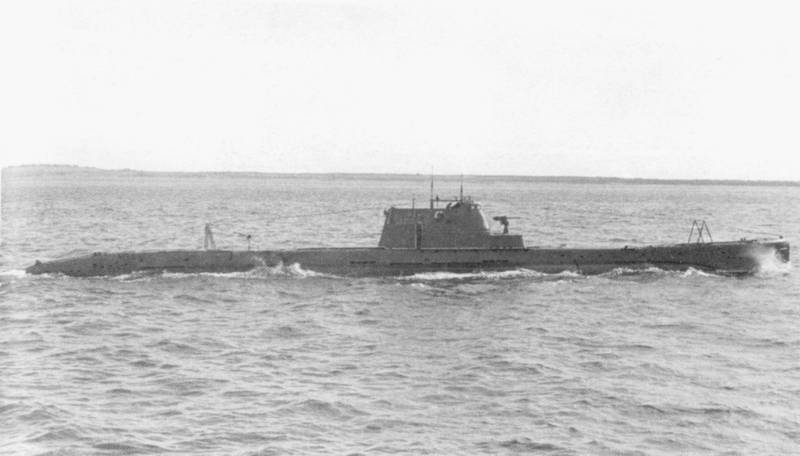
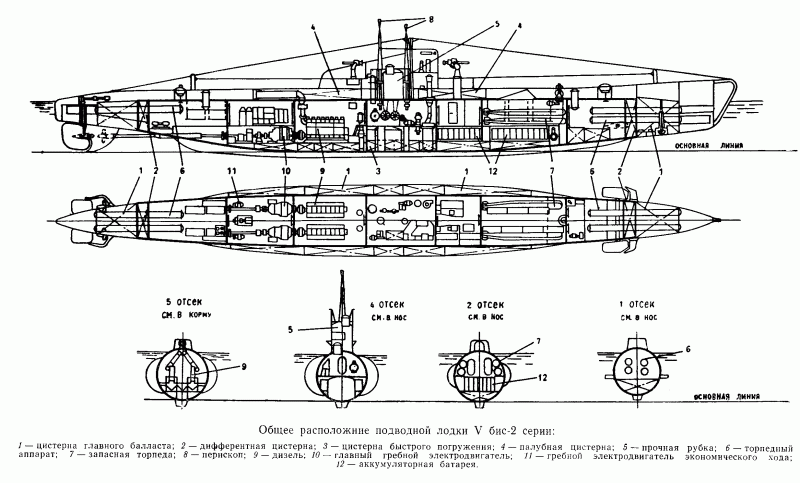
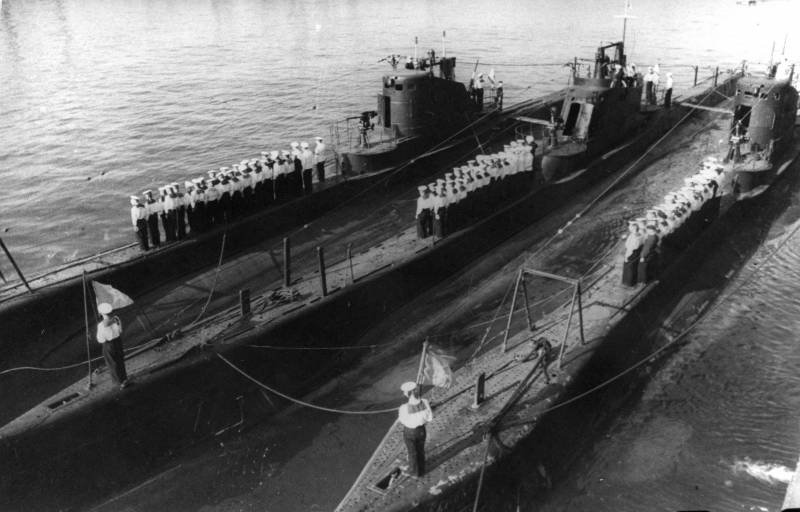
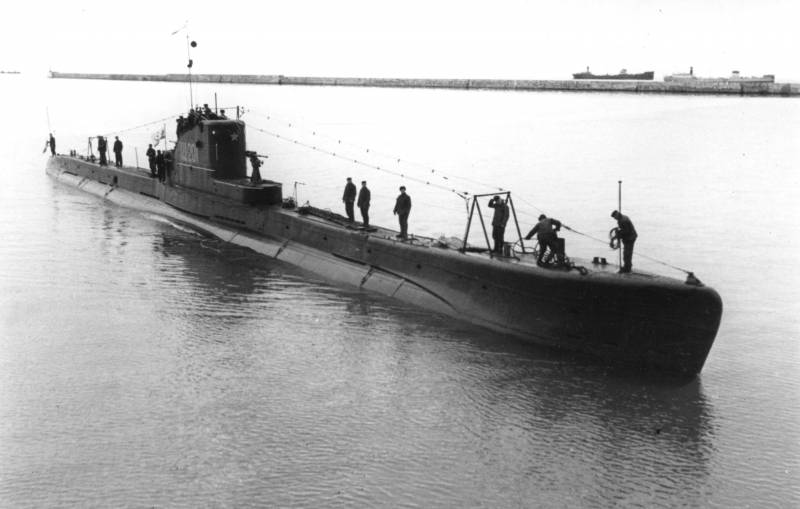
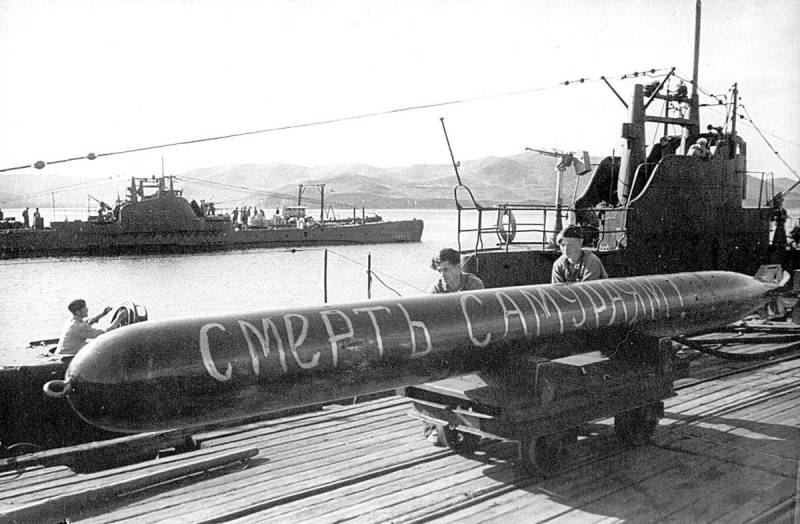
Information